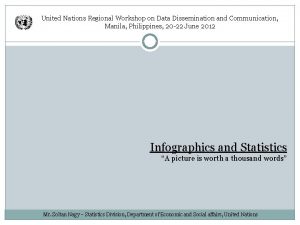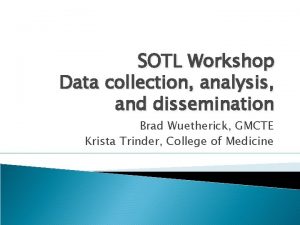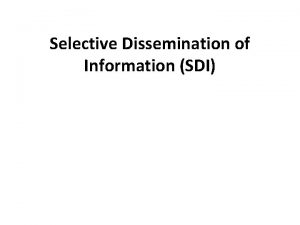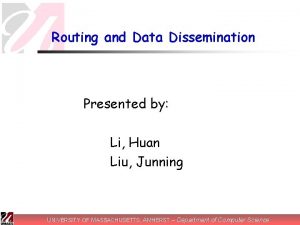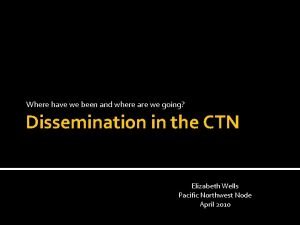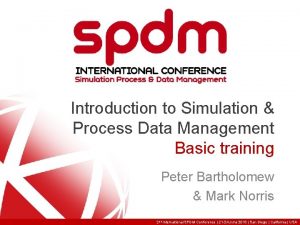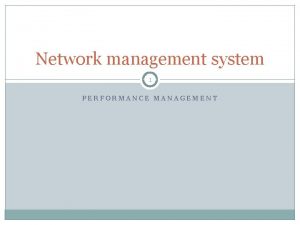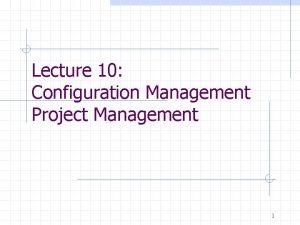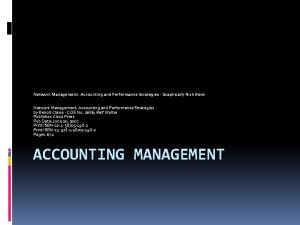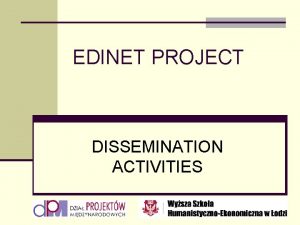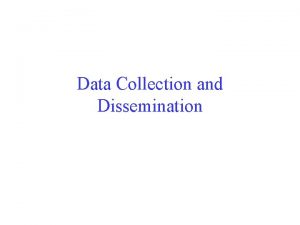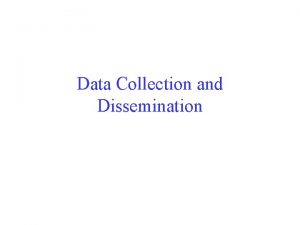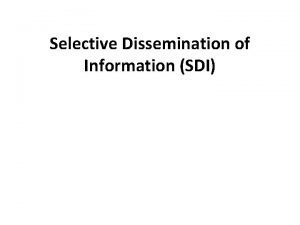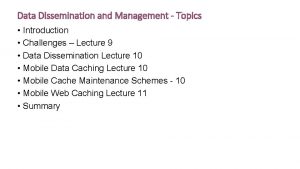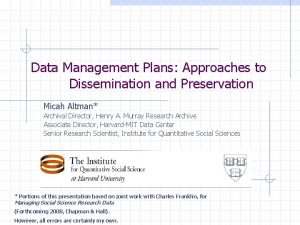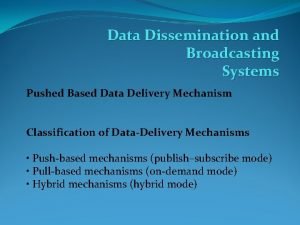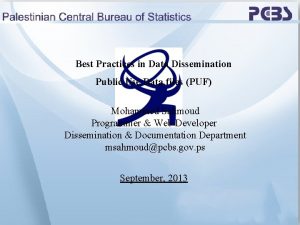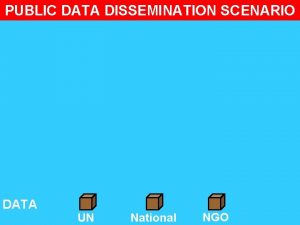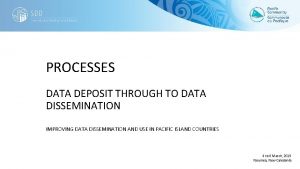Data Dissemination and Management 3 Data Dissemination and





































- Slides: 37

Data Dissemination and Management (3)

Data Dissemination and Management - Topics • • Mobile Data Caching Mobile Cache Maintenance Schemes Mobile Web Caching Summary

Mobile Data Caching • Memory Hierarchy – Processor (CPU) Registers – Cache – Main memory (RAM/ROM) – Mass storages: disks, tapes • Cache – Small, Fast memory for holding frequently used data – Improvements • Improving Data Access Latencies • Improving Data Availability

Mobile Data Caching • Cache management schemes – Predict/estimate which data items are most likely to be used in the future – Copy them to the cache memory (closer to the processor) – Cache miss and cache hit – LRU (Least-Recently Used) and Prefetching algorithms

Mobile Data Caching in Traditional Distributed Systems • Distributed Systems and Network Computing Environments • Scenario 1 – Data in the shared memory or servers – Data can be read or written by different clients concurrently (Distributed File System) • Scenario 2 – Data in the shared memory or servers – Data are read-only for the clients (WWW) • Data may be replicated onto multiple servers: improve fault tolerance and availability • A client just modified the data item before another client access it

Mobile Data Caching in Traditional Distributed Systems • Distributed Systems and Network Computing Environments • Most Crucial Problem for caching – How to maintain data consistency among the clients and servers – Complexity arises from the various failures • Server Failure • Network Failure • Client Failure • Approaches used to maintain data consistency • Polling every time • Adaptive time to live (TTL) • Leases-based invalidation

Mobile Data Caching Cache Consistency Maintenance • Purpose of caching: – Improve data access performance – Improve data availability • Trade-off : data consistency • Data Currency Requirement • Cache Consistency Maintenance Schemes depends on applications – WWW – Distributed File Systems – Client-Server Databases

Mobile Data Caching Cache Consistency Maintenance • Cache Consistency Models – Classic Techniques • Call backs and Validity Checks • Designed for distributed computing environment connected via reliable wired links • Not suitable for Mobile client (lost connection, etc) • Refetching valid data – wasting bandwidth – Strong Cache Consistency Model: • Data x(t) is the most recent x(t)? Checked with the server before access • Mobile computing environment – make it unusable when disconnections become frequent

Mobile Data Caching Performance and Architectural Issues • Various issues and Considerations for Designing Mobile Caching Strategies 1. 2. 3. 4. 5. Data access pattern Data update rate Communication/access cost Mobility pattern of the client Connectivity characteristics (disconnection frequency, available bandwidth) 6. Data currency requirements of the User (user expectations)

Mobile Data Caching Performance and Architectural Issues • Need to address the following problems – How to reduce client-side latency – How to maintain cache consistency between various cache and the servers • Being studied extensively in distributed systems and wired networking environments • Not new to mobile computing environments

Mobile Data Caching Performance and Architectural Issues • Need to address the following problems – How to ensure high data availability in the presence of frequent disconnections – How to achieve high energy/bandwidth efficiency – How to determine the cost of a cache miss and how to incorporate this cost in the cache management scheme – How to manage location-dependent data in the cache • These 4 -problems are new to the mobile computing environment

Mobile Data Caching Performance and Architectural Issues • Need to address the following problems – How to enable cooperation between multiple peer caches • Need to consider – Peer-to-Peer paradigm – Ad Hoc Networks

Mobile Data Caching • Performance and Architectural Issues Cache Organization Issues 1. Where do we cache? • • Server? Proxy? Client? Frequency, Pattern, Cost of access At server: aggregated access pattern, retrieving cost At proxy and client: access pattern, communication cost, update rate 2. How many levels of caching do we use (hierarchical caching)? 3. What do we cache (when to cache a data item and for how long)? 4. How do we invalidate cached items?

Mobile Cache Maintenance Schemes • A Taxonomy of Cache Maintenance Schemes (classification) – Cache Consistency Requirements • Strong Cache Consistency – data always up-to-date – Polling Every Time Scheme » used in Web caching – Invalidating Data On Modification Scheme • Weak Cache Consistency (some degree of inconsistency) – TTL (Time-To-Live) -based Consistency Strategies » Used in Web caching » Polling Every Time Strategies is a special case of TTL with TTL field of zero

Mobile Cache Maintenance Schemes • Invalidating-Based Strategies - Server initiates the cache consistency verification – Stateless Approach – server does not maintain info (how long) about the cache contents of the clients • Stateless Asynchronous approach – invalidation reports sent out on data modification • Stateless Synchronous approach – Server sends out invalidation reports periodically – Stateful Approach – server keeps track of the cache contents of its clients • Stateful Asynchronous approach – AS (Kahol 2001) – use a Home Location Cache • Stateful Synchronous approach – hardly any

Cache Maintenance for Push-Based Information Dissemination • A Scenario – Data item x is accessed 1% of the time at a client C and x is also broadcast 1% of the time – Data item y is accessed 0. 5% of the time at client C, but is broadcast only 0. 1% of the time – The time period of two occurrence of data items y : ty – The time period of two occurrence of data items x : tx – ty is ten times of tx: ty = 10 * tx – Cache x instead of y? • Longer delay when a cache miss happens for y • Affect the average data access delay

Cache Maintenance for Push-Based Information Dissemination • New Cache Management Schemes for Push-based Information System – Consider the cost of a cache miss – All misses – not the same cost

Cache Maintenance for Push-Based Information Dissemination • Metrics used in Mobile Computing Environment – Hit Ratio • The fraction of total data requests satisfied from the cache – Depends on cache management algorithms – Cache size – Request pattern • Assume that all cache misses have the same cost (not necessary hold in weakly connected environment) – Miss cost – depends on data size and timing

Mobile Cache Maintenance Schemes Broadcasting Timestamp Scheme

Mobile Cache Maintenance Schemes Broadcasting Timestamp Scheme • Data server periodically broadcasting invalidation reports – All the invalidations in a time window of the last w time units – Window size w: – (disconnected from the network) • An invalidation notification from the server: (id, ts) – id: identifier of a data item – ts: timestamp denoting the time when data item was modified, i. e. – t: the time when the invalidation report was sent by the server – t – w ≤ ts ≤ t

Mobile Cache Maintenance Schemes Broadcasting Timestamp Scheme • A Mobile Client m – Received an Invalidation Report with timestamp t: IR(t); within w time units from last invalidation report – Performs (For each data item id in m’s cache) • Find each data item id in m’s cache with (id, ts) found in report IR(t) • If timestamp < ts, stale the cache entry for id, and delete the data item • Otherwise set the timestamp = t for the cached entry

Mobile Cache Maintenance Schemes Broadcasting Invalidation Reports • Cache Consistency Management Schemes based on Broadcasting Invalidation Reports – Broadcasting Timestamp (BT) Scheme – Fig 3. 7 – A Variant of Broadcasting Invalidation Report (Jing and Colleagues, 1997) - Adjust the size of the invalidation report to minimize the use of wireless bandwidth while retaining the effectiveness of cache validation – Two-Level Caching Scheme based on mobility agents that takes into account the Mobility Pattern (Liu and Maguire, 1996) – Broadcasting Invalidation Report methods take into account the update and query rate/patterns and client disconnection time to optimize query cost (Hue and Lee 1998)

Mobile Cache Maintenance Schemes Broadcasting Invalidation Reports • Other Cache Consistency Management Schemes based on Broadcasting Invalidation Reports – Common Characteristics • Stateless server, and neglect the issue of mobility • The entire cache is invalid if the client is disconnected for a period longer than the period of the broadcast

Mobile Cache Maintenance Schemes Disconnection Operation • Some information is better than no information • Disconnection Operation – Is permitted if data availability is more important than data consistency – Should not be permitted If obtaining current data is more important • Trade-off – Availability – Consistency

Mobile Cache Maintenance Schemes Disconnection Operation – Coda System • CODA – A distributed file system, assumes a stateful server – Support disconnected operations on shared files in UNIX-like environments • Coda Clients – Hoarding files (a cache maintenance scheme) – What data items (files) do we hoard? • use Prioritized Scheme with user assigned priorities on data items – When and how often do we perform hoarding? – How do we deal with cache misses? – How do we reconcile the caches version of the data items with the version at the server?

Mobile Cache Maintenance Schemes Asynchronous Stateful (AS) Scheme • AS Scheme ensures that the data returned to a mobile client is at most t seconds old, where t is the max latency of forwarding an I. R. from the server to the client via its HA • Designed for applications that require strict data currency guarantees and in which access to stale data is undesirable • Such applications include access to critical data such as Bank Account info, and Air Traffic Info

Mobile Cache Maintenance Schemes Asynchronous Stateful (AS) Scheme • Use – Cache consistency maintenance through Asynchronous invalidation reports (call backs) • Send – Invalidation reports to mobile client (MH) only when some data changes • Home Agent – Keep track of what data have been locally cached at its mobile hosts (cache state info of the mobile host) – A HA can be maintained at any trusted static host – Pass all messages between the Mobile Host and Data server – To assist with handling disconnections

Mobile Cache Maintenance Schemes Asynchronous Stateful (AS) Scheme • Home Location Cache – HLC can be viewed as a Proxy – Hold a list of records for Mobile Hosts (x, T, Invalid Tag) x – Identifier of a data item T – Timestamp of the last invalidation of x Invalid Tag – TRUE (invalidation has been sent to the host, but no ACK yet)

Mobile Cache Maintenance Schemes Asynchronous Stateful (AS) Scheme • Assume the following Computing (Operation) Scenario – The application program runs on the client and communicates with the data server through messages – Client Request Data Item • Client → Uplink Request (Query) → Data Server • Client saves some data in its local memory to minimize the number of data request – Data Server Replying • Data Server → Downlink Reply (data) → Client

Mobile Cache Maintenance Schemes Asynchronous Stateful (AS) Scheme • Assumptions – No message is lost due to communication failure or otherwise in the wired network – Data server update any data items → Send an Invalidation Message → all Home Agents via the wired network – Home Agents forwards Invalidation Message to the relevant Mobile Host – Mobile Host • Can detect if connected to the network or not • Receives the Invalidation Message (through roaming and is not disconnected) • Informs HA before it stores (or updates) any data item in its local cache

Mobile Cache Maintenance Schemes Asynchronous Stateful (AS) Scheme • A Mobile Host (MH) operates in two modes – In the Sleep Mode • Unable to receive any invalidation messages • Suspends processing of any queries from the applications • Each Mobile Host maintains a Cache timestamp for holding the timestamp of the last message received from its Home Agent • The HA uses the cache timestamp to discard invalidations that is no longer needs

Mobile Cache Maintenance Schemes Asynchronous Stateful (AS) Scheme • A Mobile Host (MH) operates in two modes – Wake up after a Sleep • Send a probe message to its HA with its cache timestamp • The probe message is piggy backed on the 1 st query after the wakeup to avoid unnecessary probing – HA response to the probe message (invalidation check) • Sends an invalidation report – MH determines which data items changed while disconnected – Defers answering all queries that it received, until it has received all the invalidation report from its HA

Mobile Cache Maintenance Schemes Asynchronous Stateful (AS) Scheme • A Example Scenario (Figure 3. 9) • Cache Timestamp t 0 – Two data items: IDs x and z • Timestamp t 1 – The HLC received an I. Message noting that data item x changed at the server at time t 1 – Forward invalidation (x; t 1) to HLC and MH – MH updates its cache timestamp to t 1, and delete x from the cache – MH wants to access y by sending a data request (y; t 1) to the HLC – HLC responds, fetches y, and send it (y; t 2)

Mobile Cache Maintenance Schemes Asynchronous Stateful (AS) Scheme • Timestamp t 2 – MH updates its timestamp to t 2, adds y to the cache • Timestamp t 3 – MH get disconnected – sleep mode – y changed, and Invalidation message for y is lost • Timestamp t 4 – – Wakeup Z changed, and invalidation message for z is sent Ignore all invalidation messages until the 1 st query Query + Probe (*, t 2) • Timestamp t 5 – Invalidate message (y, x, t 5)

Mobile Cache Maintenance Schemes Asynchronous Stateful (AS) Scheme

Mobile Cache Maintenance Schemes To Cache Or Not • If x is never modified – cache a copy at MH m • If x is modifiable? Decision to cache x? – SA Always – SA Never • Online Algorithms (Dynamic Optimization)

Mobile Cache Maintenance Schemes To Cache Or Not • Sliding-Window Dynamic Data Allocation Scheme (Sistla, Wolfson, and Huang – 1998): determine when to cache a data item a mobile client – Choose AS Always or SA Never based on the recent access pattern history – The history is maintained as a window of size k, and relevant access operations • Read operation at the mobile node (rm) • Write operation at the server (ws) – The irrelevant operations • Write operation at the mobile node (wm) • Read operation at the server (rs)
 Data dissemination
Data dissemination Data dissemination diagram
Data dissemination diagram Collection analysis dissemination of data
Collection analysis dissemination of data What is a dissemination plan
What is a dissemination plan Features of selective dissemination of information
Features of selective dissemination of information Components of selective dissemination of information
Components of selective dissemination of information Challenges of information dissemination
Challenges of information dissemination Dissemination
Dissemination Dissemination
Dissemination Dissemination
Dissemination Dissemination
Dissemination Ctn dissemination library
Ctn dissemination library Top management and middle management
Top management and middle management Top management middle management first line management
Top management middle management first line management Top management and middle management
Top management and middle management Behavioural management theory
Behavioural management theory Contemporary issues in management ppt
Contemporary issues in management ppt Demand management and capacity management
Demand management and capacity management Data governance and risk management
Data governance and risk management Lab 7-1: scripting in the bash shell
Lab 7-1: scripting in the bash shell Data plane control plane and management plane
Data plane control plane and management plane Nafems pse
Nafems pse Meter data management roadmap
Meter data management roadmap Database systems maximize
Database systems maximize Data collection management and analysis
Data collection management and analysis Profisee mds
Profisee mds Time management in human resource management
Time management in human resource management Performance management in network management
Performance management in network management Managing assets vs asset management
Managing assets vs asset management Configuration management in project management
Configuration management in project management Types of e crm
Types of e crm Organized retail
Organized retail Principles of cost management
Principles of cost management Accounting management in network management
Accounting management in network management Hrm vs hrd
Hrm vs hrd Tahapan sales cycle
Tahapan sales cycle Quality management in operations management
Quality management in operations management Traditional management vs entrepreneurial management
Traditional management vs entrepreneurial management

